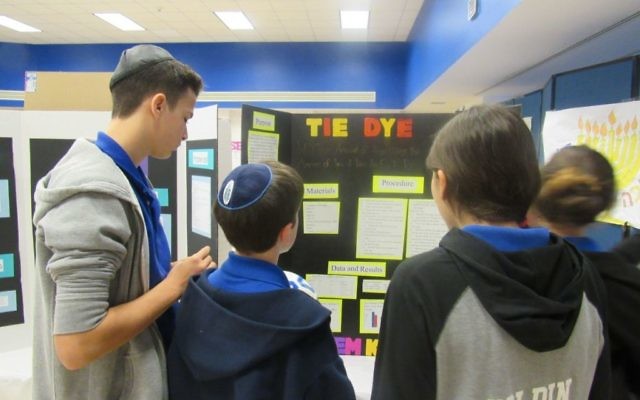Baseball, Rubber Bands, Baking
Atlanta Jewish Academy held its annual Junior High Science Fair in mid-December, with 66 projects examined by 14 judges.
“All our judges told me that they were very impressed by the quality of the students’ work,” said AJA Junior High science teacher Suzanne Sears, who coordinated the science fair. “Judges who have participated in our science fair before and know what to expect thought our students had taken a step forward with their projects this year.”
The overall winners, Gabriel Weiss for the seventh grade and Ari Slomka for the eighth grade, advanced to the Fulton County Regional Science & Engineering Fair, being held Friday and Saturday, Jan. 22 and 23.
Gabriel’s project, “Good Vibrations,” tested whether the length of a rubber band affects the length of time it vibrates. Because he’s a musician, the project was a natural fit.
“I liked the fact that we had the freedom to do what we wanted and could bring our own creativity into the project,” he said.
Ari’s project, “Ori-Dynamics in Action,” investigated how surface area affects drag. Ari made different types of origami stars to determine whether the surface area affects the distance a star travels when thrown. The project gave Ari his second overall win in the AJA Junior High Science Fair.
One of Sears’ judges was not like the others: AJA Upper School junior Shaun Regenbaum, whose entry in the 2015 Junior Breakthrough Challenge, a video explaining the mathematical concept of infinitesimals, finished among the top 15 worldwide.
“Shaun was a positive, enthusiastic judge who understood what makes a quality experiment,” Sears said. “He made sure that the younger students fully grasped the concepts behind their projects.”
In addition to the overall winners, AJA named first-, second- and third-place projects for seventh and eighth grades.
For seventh grade:

- First place — Matthew Minsk, “Batting or Pitching: Which Is More Enriching?” Matthew analyzed Major League Baseball data to determine whether a team’s batting average or earned-run average is more closely correlated to games won. He chose the project based on his passion for baseball and his fondness for math and someday hopes to use his discoveries in the front office of a major-league team.
- Second place — Wade Rabinowitz, “Rise, Rise as Fast as You Can.” Wade examined the heights of muffins baked with different rising agents. Wade loves to bake and disproved her initial assumption that yeast would be the most effective leavening agent.
- Third place — Shayna Shapiro, “You’re in for a Ride.” Shayna tested how the size of a marble affects the time it takes to travel through a roller-coaster track. “I really like physics,” she said, “so even though I was nervous about speaking to the judges, I enjoyed having the chance to show them my project and tell them how I did it.”
For eighth grade:
- First place — Zach Mainzer, “Under the Dirty, Polluted Sea.” Zach tested how different types of road surfacing affect the vitality of water fleas. Zach had always done baseball-related projects. “I still love baseball,” he said, “but I wanted a project where the variables were easier to control and with more experimentation.”
- Second place — Eitan Linsider, “Mega-Magnets.” Eitan examined the strengths of different types of magnets. He also tested how the strength of the magnets changes when they are heated or cooled. Eitan has always been interested in magnets and how they work.
- Third place — Sophie Steinberg, “It’s TIME for Chocolate.” Sophie found the relationship between the melting point and the amount of cocoa powder in chocolate. “I liked the fact that chocolate is such an everyday thing, which makes the experiment very practical,” she said.





comments